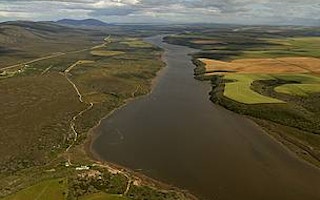Major river basins in Africa, Asia and Latin America could sustainably double food production in some of the poorest parts of the globe in the next few decades, water experts reported on Monday.
But myriad competing claims on the water — from industry, cities and power producers among others — may stand in the way of a big increase in food production.
Scientists in 30 countries spent five years analyzing river basins that cover a total of 5.2 million square miles (13.5 million square km) and are home to 1.5 billion people, including 470 million of the world’s poorest.
“There is scarcity in certain areas, but our findings show that the problem overall is a failure to make efficient and fair use of the water available in these river basins,” said Alain Vidal, director of the Challenge Program on Water and Food, which produced the report.
“This is ultimately a political challenge, not a resource concern,” Vidal said in a statement.
River basins provide a wide range of services — irrigation water, food, direct supplies for industry and domestic use — but because water supply is limited, those in power in certain areas sometimes claim disproportionate amounts of the resource.
This can change, said Simon Cook, who led the study.
“There’s plenty of capacity to produce food without actually running into the water crisis,” Cook, of the International Center for Tropical Agriculture, said by telephone.
Increasing productivity
Increasing food production is particularly important in the developing world, where population is rising and some of the most damaging effects of climate change — droughts, wildfires, floods, severe storms — are likely to hit hardest. World population is expected to grow from about 7 billion now to more than 9 billion by 2050.
Conflicts over access to water are as old as the first well, but Cook and others presenting research at the XIV World Water Congress in Recife, Brazil, recommend a holistic approach that emphasizes increased productivity and communication between all those who use the water.
A river basin includes all the territory drained by a river and its tributaries.
The basins studied were the Andes and Sao Francisco in South America; the Limpopo, Niger, Nile and Volta in Africa and the Ganges, Indus, Karkheh, Mekong and Yellow River in Asia. They were chosen because they have the full range of water-related challenges in the developing world.
Africa has the biggest scope to increase food production in its river basins, but parts of Asia and Africa have areas where production is at least 10 percent below its potential, and in some places, productivity is only 10 percent of what it could be, Cook said.
Increased access to fertilizers, financing and markets could help, he said.
The key is dialogue among all those who use the water in the basin, Cook said: Farmers whose crops are rain-fed, farmers who use irrigation, herders and ranchers, city-dwellers, factory owners and workers and hydropower producers and users.
These discussions need to be across economic sectors and across borders, the scientists suggested.










